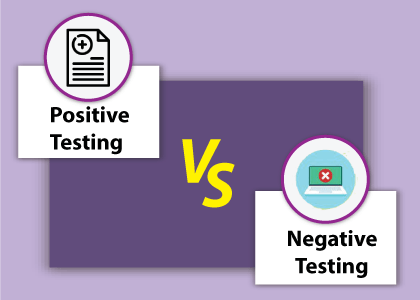The primary objective of performing the software testing is to identify the bugs in the code and enhance the quality of software or an application.
To achieve this, we have two different but unique software testing approaches, such as positive testing and negative testing.
Both of these testing strategies have their prime features and functionality, and both testings play a significant role to check the software or an application.
To test any kind of application, we need to provide some input value and validate if the results are based on the given requirements or not.
Before understanding the significant difference between positive and negative testing, we will briefly introduce positive and negative testings with some examples.
What is Positive Testing?
It is used to check whether our application works as expected or not. And if an error is detected at the time of positive testing, the test is considered as fail. A positive testing is a technique whenever a test engineer writes the test cases for a set of respective outputs.
In positive testing, the test engineer will always check for only a good set of values.
In other words, we can say that positive testing is a process where the system or an application is tested against the valid input data.
And the primary purpose of performing the positive testing is to validate whether the software does what it is supposed to do.
In simple terms, we can say that positive testing is implemented by providing a positive point of view.
For example, Numbers like 9999999.

Example of Positive Testing
In the following example, we are trying to understand the working of positive testing.
- Suppose, we have one test scenario, where we want to test an application that includes a simple text box.
- To enter Phone Number according to the business needs it accepts only numerical values.
- Hence, in positive testing, we will only give the positive numerical values in order to test whether it is working as per the requirement or not.
Note: Generally, most application developers execute the Positive scenarios where the test engineer gets less bug count around positive testing.
To get in-detail information about positive testing, refers to the following link:
What is Negative Testing?
It is implemented to check how the application can gracefully handle invalid input or unpredicted user performance.
The fundamental purpose of executing the negative testing is to ensure the application's stability against the effects of different variations of improper validation data set.
Negative testing is also known as error path testing or failure. And it helps us to identify more bugs and enhance the quality of the software application under test.
Once the positive testing is complete, then only we can execute the negative testing, which helps to identify more bugs and enhance the quality of the software application under test.
We can say that the negative testing is executing by keeping the negative point of view in simple terms. For example, 99999abcde

Example of Negative Testing?
Let see one example which will help us to understand the negative testing in an effective way.
- Suppose we have one sample form where the Mobile Numberfield can only accept the numbers' value and does not accept the unique characters and alphabets values.
- However, let's entered the unique characters and alphabets values on the Mobile numberfield to test that it accepts the individual characters and alphabets values or not.
- We expect that the textbox field will not accept invalid values and show an error message for the incorrect entry.
To get in-detail information about negative testing refers to the following link:
Example for Positive and Negative testing
The positive method is the same to the negative testing. But the significant difference between them is, in positive testing, we will enter the valid data instead of false data, and the expected result is the system accepting the code with no further issues.
Let's see another example where we will see the Positive and negative test scenarios:
Suppose we have one requirement, where the Password text box field should accept only 8-15 alphanumeric characters.
Let see the below table where we discussed some of the positive
and negative test scenarios.
|
Positive Test
Scenarios |
Negative Test
Scenarios |
|
The Password text
box should accept 8 characters. |
The Password text
box should not accept less than 8 characters. |
|
The Password text
box should accept 15 characters. |
The Password text
box should not go beyond more than 15 characters. |
|
The Password text
box should accept any value between 8-15 characters long. |
The special
characters should not accept by the password text box. |
|
The Password text
box should accept all numeric and alphabet values. |
Positive Testing VS
Negative Testing

|
S.No. |
Positive Testing |
Negative Testing |
|
1. |
Checking the
application response with the help of valid input data is known as positive
testing. |
Checking the
application response by using the invalid input data set is known as negative
testing. |
|
2. |
Positive testing is
implemented only for the expected conditions. |
Negative testing is
implemented only for unexpected conditions. |
|
3. |
Positive testing
doesn't guarantee a good quality of software product. |
Negative testing
guarantees to deliver a good quality of software product. |
|
4. |
The execution of
positive testing takes less time as compared to negative testing. |
The execution of
positive testing takes more time as compared to positive testing. |
|
5. |
To validate the
available set of test conditions, we will consistently implement the Positive
testing. |
To break the project
and product with an unidentified set of test conditions, we will consistently
implement Negative testing. |
|
6. |
The primary purpose
of executing Positive testing is to guarantee that the software application
always meets the developer's requirements and specifications. |
The primary purpose
of executing the negative testing is to test a web application's constancy in
contradiction to inaccurate validation data sets. |
|
7. |
Positive testing
doesn't encompass all the possible cases. |
Negative testing
encompasses all the possible cases. |
|
8. |
It is a process
where the system is validated in contradiction of the valid input data. |
It is a testing
process which contain the validation in contrast to invalid input data. |
|
9. |
Positive testing is
less significant than Negative testing. |
Negative testing is
more vital than Positive testing. |
|
10. |
Positive testing can
be implemented on every application. |
Negative testing can
be implemented when the possibilities of unpredicted conditions. |
|
11. |
The people having
less knowledge can execute the positive testing. |
The testing
professionals can execute the negative testing. |
|
12. |
It makes sure that
the software is standard. |
Negative testing
makes sure to deliver 100 percent bug-free software. |
Conclusion
After seeing the significant comparison between positive and
negative testing, we can conclude that
testing helps us to increase the software application quality and ensures the
software is bug-free before the software is launched.
As the name recommends, they are two opposing techniques but
highly effective in getting quality software at the end of the day.
The fundamental purpose of implementing the Positive and
Negative Testing is to verify that the application works as per the given
business needs and specifications and provides us enough assurance in the
software's quality.
And finally, we can say that Positive testing and Negative
testing are like two sides of a coin, which implies that we cannot overlook
anyone's significance in any case.
If both are implemented, the output is overwhelming; if we
ignored one of them, the final product would be unpleasant.



0 Comments